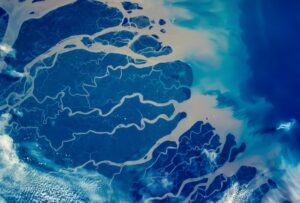By now, it’s old news — 66 million-year-old news — that the asteroid that caused the dinosaur extinction hit what’s now the Yucatan Peninsula. But until recently, no one knew that it came down in spring. The recently discovered puzzle piece might explain why the event killed off some species but not others.
A February study published in the prestigious journal Nature uses fossil research to suggest that the 11km-wide asteroid hit (ironically) during the season of renewed life.
The study stemmed from the unusual discovery of a “fossil graveyard” in 2019. Tanis, North Dakota contains a dense group of fossilized animals. A tsunami-like wave filled with rocks and glass buried the animals alive, probably killing them within an hour of the asteroid’s impact.
If that was the case, researchers reasoned, they could find out the time of the impact.

A paddlefish fossil from the North Dakota deposit. Photo: Melanie During
Growth rings on fossils
“It was obvious to us that we needed to analyze these bones to get valuable information about the moment of the impact,” said Melanie During of Uppsala University in Sweden, the study’s lead author.
The group took the fossils to the European Synchrotron Radiation Facility in France. They examined them with a particle accelerator and discovered seasonal growth on the bones, similar to the radiating ring patterns of trees. The scans also showed that the shape and size of the bones varied with the seasons.

France’s European Synchrotron Radiation Facility. Photo: ESRF
The fossilized specimens consisted mainly of paddlefishes and sturgeons. Dennis Voeten, also of Uppsala University, explained that all fishbone cells grow differently during different seasons. The accelerator made the differences visible, and researchers then determined when the asteroid hit.
“We saw that both cell density and volumes were on the rise but had not yet peaked during the year of death, which implies that growth abruptly stopped in spring,” Voeten said.
Why the dinosaur extinction event didn’t kill everything alive
The findings explain why some species survived the extinction and others didn’t, thanks to animal life cycles.

A triceratops skull. Photo: Ivan Radic
Unlike dinosaurs and some marine life, numerous animals like birds, crocodiles, and snakes survived the impact and resulting ash cloud. Most of the survivors, the team found, probably inhabited the Southern Hemisphere.
The asteroid hit during the Northern Hemisphere’s spring. That meant animals and plant life were ending their hibernation periods or just starting life — conditions that left them exposed to extinction. On the other hand, it was fall in the Southern Hemisphere, where species could be preparing to hibernate or hunkered down.
“Southern Hemisphere ecosystems, which were struck during austral autumn, appear to have recovered up to twice as fast as Northern Hemisphere communities, consistent with a seasonal effect on biotic recovery,” the study says.
The team hopes that the findings lead to the (astounding) ability to pinpoint the exact date that the asteroid hit.






